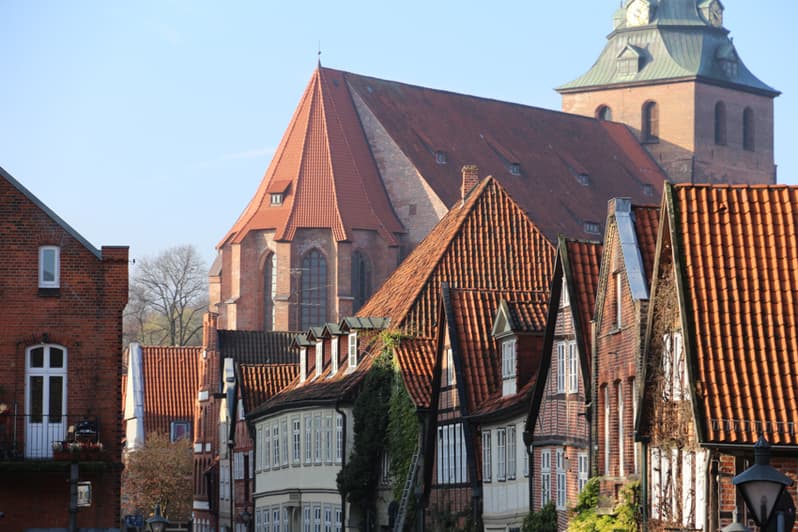©Partner der Lüneburger Heide GmbH

©Partner der Lüneburger Heide GmbH

©Partner der Lüneburger Heide GmbH

©Partner der Lüneburger Heide GmbH

Nicol List war der Anführer der berüchtigsten Räuberbande Deutschlands im 17. Jahrhundert. In der Weihnachtsnacht 1697 schleichen sich die Räuber um Nicol List durch die menschenleeren Straßen der Lüneburger Altstadt und dringen über eine Seitentür in die St.Michaeliskirche ein und entwendeten Gold, Silber und Edelsteine.
Erfahren Sie hier:
- Wer war der Nicol List?
- Wie Nicol List in die Kirche eindringen konnte.
- Warum ihm ausgerechnet dieser Millionenraub zum Verhängnis wurde.
- Was der Nicol List mit "Die Räuber " von Friedrich Schiller zu tun hat.
Wer war der Nicol List?
Dr.
Johann Rudolph Freiherr von Mosel heißt in Wirklichkeit Nicol List und
stammt aus Sachsen. Seine Kameraden sind der Hamburger Seemann Christian
Schwancke, die desertierten Soldaten Christian Müller und Andreas
Schwartze, die ehemaligen Gardereiter Jürgen Kramer und Christoph Pante,
der Honigkuchenbäcker Michael Kayser aus Wunstorf bei Hannover und der
ehemalige Militärchirug Samuel Löbel aus Polen.
Nicol List öffnet
schon als Stallbursche alle Schlösser. Als Kavallerist siegt er 1675
bei Fehrbellin mit dem Großen Kurfürsten gegen die Schweden und 1683 vor
Wien mit Johann Georg III. von Sachsen gegen die Türken. Der Versuch
als Gastwirt und Pferdehändler ehrlich zu leben, scheitert an seinen
alten Kameraden, die als Räuber durch Städte und Dörfer ziehen.
List
nutzt seine bürgerliche Existenz als Tarnung und führt seine
Räuberbande zu spektakulären Einbrüchen. 1694 steigen die Diebe in das
Braunsdorfer Schloß des Freiherrn von Meusbach ein und stehlen
Silbergeschirr und 4000 Taler (ca. 120.000 Euro).
1696
kommt die Justiz dem Räuber auf die Spur. Ein Richter lässt nachts das
Gasthaus umstellen und weckt den Nicol List mit einem Haftbefehl. Noch
im Nachtgewand reißt List eine Pistole von der Wand, schießt zwei Männer
nieder und galoppiert in der Dunkelheit davon. Nun als Mörder gejagt,
wechselt der Räuber das Revier und beginnt sich als Freiherr auszugeben.
Er plündert eine Kirche im bayrischen Hof, einen Goldschmied im
thüringischen Altenburg und einen kurfürstlichen Amtmann bei Magdeburg.
Im Frühjahr 1697 reist List, als Arzt getarnt, nach Hamburg. "Ich heiße List, und listig bin ich",
pflegt der falsche Doktor zu sagen. Seine eigenhändig angerührte
Medizin verkauft sich tadellos. List könnte davon gut leben, aber er
will mehr.
Beim Auskundschaften günstiger
Einbruchsgelegenheiten ist der Plan neu beschlossen, denn das Leben in
der Hansestadt ist teuer - die Schätze der St.Michaliskirche in Lüneburg.
Wie Nicol List in die St.Michaeliskirche eindringen konnte.
Nächstes Objekt der Begierde ist ein Kleinod abendländischer Kunst, die weltberühmte "Güldene Tafel" der Klosterkirche St.Michaelis zu Lüneburg.
In dem Schrein werden Kostbarkeiten und Reliquien aufbewahrt. Ein Millionenschatz!
Als
der Küster für Besucher das Schloß des Schrein öffnen will, stellt er
fest, dass es seltsam verklemmt ist und entdeckt, dass Gold, Silber und
rund 200 Edelsteine verschwunden sind.
Nicol
List und seine Bande hinterlassen keine Spuren. Er hatte mit der
Herstellung der Schlüssel eine glänzende Probe seiner Fähigkeiten in der
Feinmechanik abgelegt. So kommt es, dass zunächst niemand etwas von dem
Gaunerstück ahnt. Als man den Raub einige Wochen später bemerkt, war
das Diebesgut schon längst unter den Dieben verteilt.
Warum ihm ausgerechnet dieser Millionenraub zum Verhängnis wurde.
Der
Diebstahl macht den Räuberhauptmann im ganzen Land berühmt. Die Beute
bringt Hunderttausende ein, doch das Geld zerrint ihm zwischen den
Fingern.
Nicol List ist der erste Räuber, der per Steckbrief gesucht wird.
Der Gastwirt, bei dem die Bande abstieg, meldet sich nach dem Einbruch
und von ihm führt eine Spur bis zu List. In Bayern lauern ihm Häscher
auf. Sie müssen ihn dreimal mit Knüppeln zu Boden schlagen, bis er
liegen bleibt. In einem Käfig wird er nach Celle gebracht. Dort wird die
Bande im März 1699 öffentlich exekutiert. Auf seinem letzten Gang zeigt
List Haltung, obwohl ihn eine grausame Todesstrafe erwartet. Mit acht
kräftigen Schlägen zerschmetterte ihm der Henker erst Beine und Arme, um
ihn dann mit einem Beil den Kopf abzuschlagen. Lists Körper wurde zur
Asche verbrannt, sein Kopf auf einen Pfahl genagelt - das schaurige Ende
eines Mannes, dessen zweifelhafter Ruhm nun auch die letzten Reste des
Gebäudes überdauern wird.
Was der Nico List mit "Die Räuber" von Friedrich Schiller zu tun hat.
Das
Buch über seinen Prozess wurde bis 1733 sechsmal aufgelegt, so gut wie
jedes Werk über die deutsche Kriminalgeschichte nennt seinen Namen und
Friedrich Schiller hat Teile aus dem Leben Lists und aus dem
Prozessverlauf in "Die Räuber" verwendet hat.




